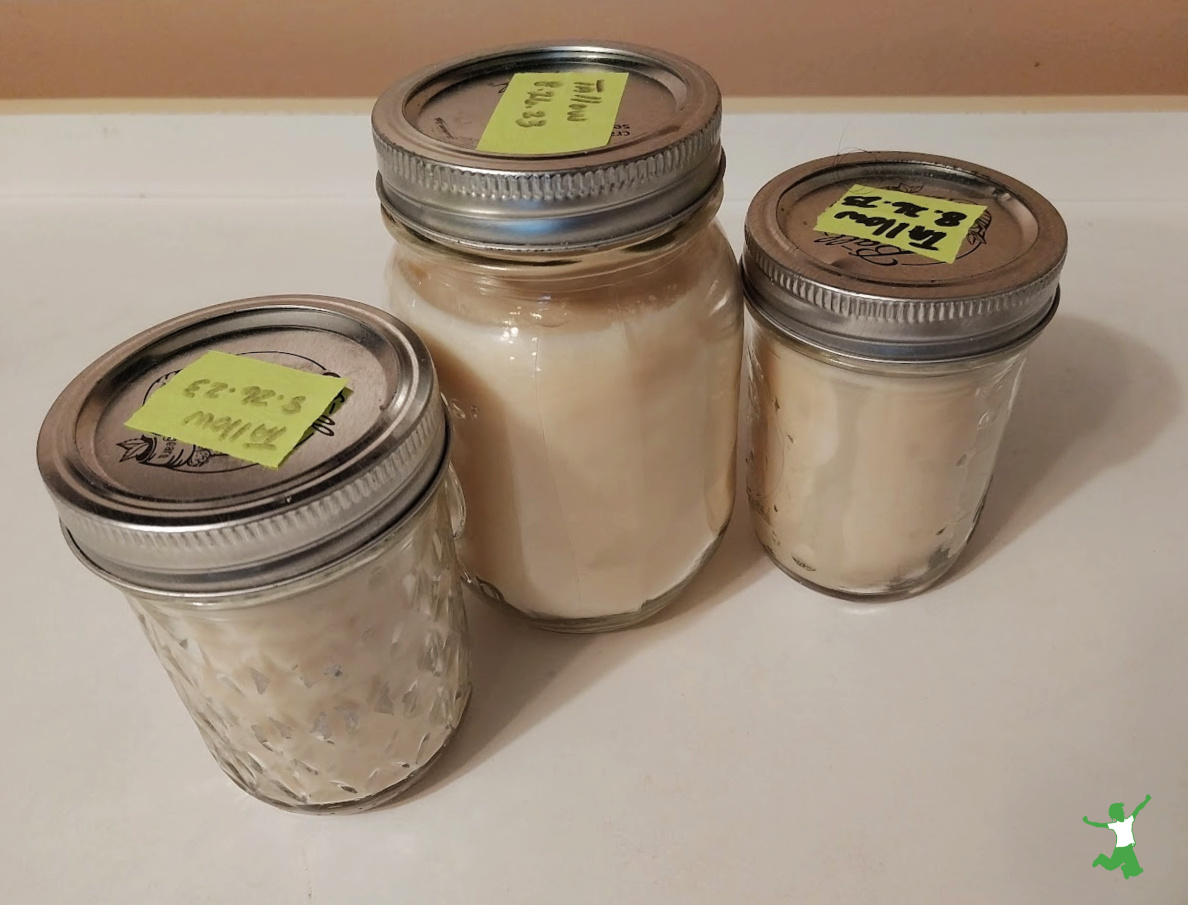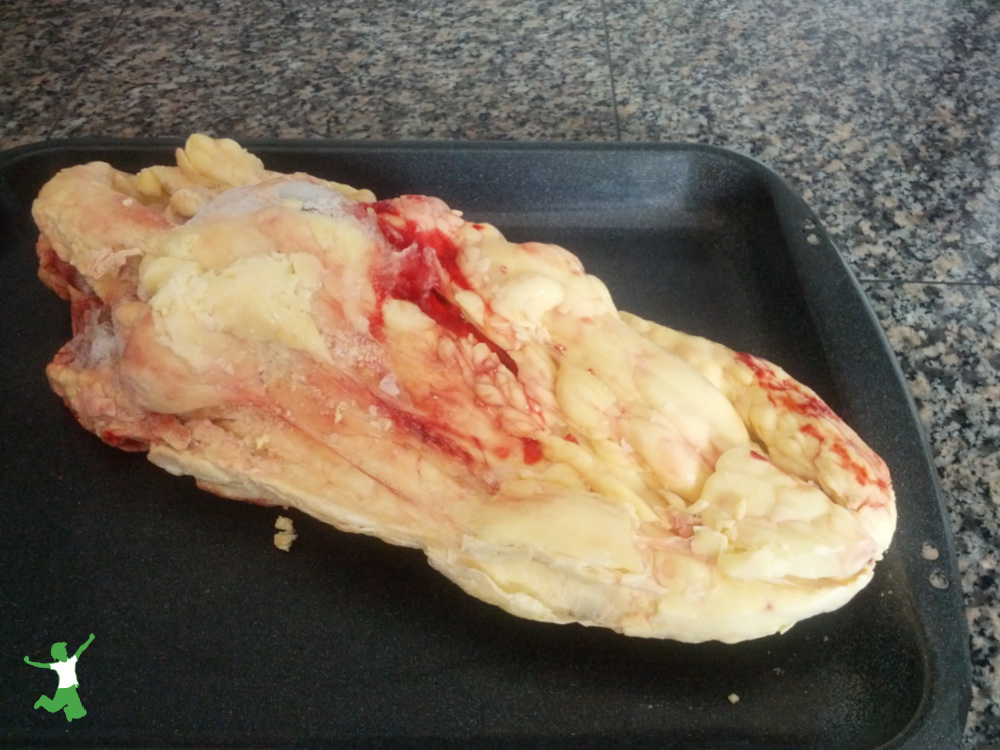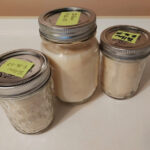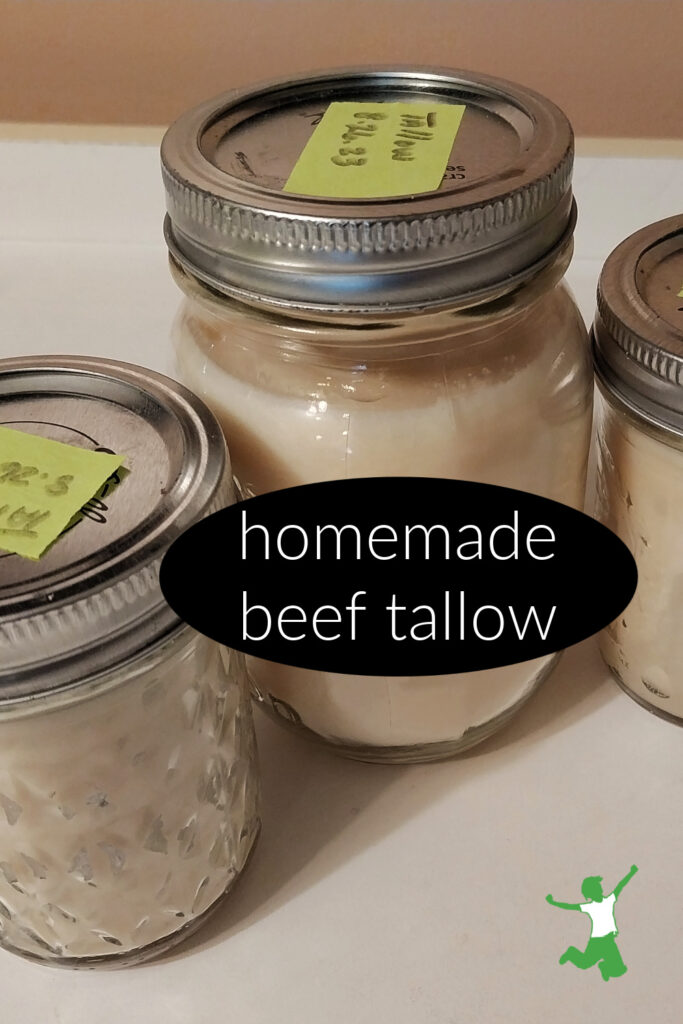How to render tallow from an intact piece of beef suet from your grassfed farmer. This traditional recipe with video how-to makes several jars of tasty pastured beef tallow to last you many months or even a year!

Tallow is hands down my favorite traditional fat to use for frying. I like it even more than lard. It is ideal for this purpose as it has less than 3% polyunsaturated fats. This amount is just a bit less than coconut oil.
What’s more, if your tallow comes from cattle finished on grass or given grain for a very short period of time (a few weeks at the most) before processing, a good share of those polyunsaturates are in the form of conjugated linoleic acid (CLA).
This fatty acid helps build muscle, assists with weight loss, and drastically reduces cancerous tumor risk.
These are just a few of the many health benefits.
Beef Tallow: Not Just Any Fat
Tallow is a very special type of beef fat.
It is the rendered form of suet, which is the nutrient-rich beef or mutton fat found around the organs, particularly the kidneys.
It is the highly prized nourishing fat used in pemmican, a traditional food used by Native Americans to survive harsh winters. Sometimes they subsisted on nothing else for weeks on end with no loss in health!
Traditional pemmican includes tallow in a 1:1 ratio with dried and powdered, ideally, grass-fed muscle meat. It is the ultimate survival food.
Besides CLA, another notable fat present in high amounts in beef tallow is palmitoleic acid, which is highly anti-viral and anti-bacterial.
Fatty Acid Profile
The fatty acid profile of beef tallow is approximately 55% saturated fats and 40% monounsaturated fats.
Both of these fatty acids are very heat stable and do not easily produce free radicals when heated, unlike toxic liquid seed oils.
The smokepoint for tallow is at least 350°F (177°C). Some sources put it as high as 400 °F (204°C), making it an excellent choice for frying.
Preparation and Storage
Rendering pastured tallow is a simple process. It is very similar to the method for rendering pork lard.
From start to finish, the how-to video demonstration in the recipe below shows you exactly what you need to know to produce several jars full that will last you a very long time!
My favorite dishes for using homemade tallow are stovetop french fries, roasted vegetables, hush puppies and shelf-stable pemmican (for the emergency pantry).
Note that pastured tallow is a beautiful yellow color when liquid immediately after you render it. The color lightens to beige at room temperature and in the refrigerator. It whitens a bit further in the freezer.
If you live in a cool climate, tallow keeps well in the pantry.
I choose to refrigerate as this is my preference in hot, humid Florida.
In my experience, rendered beef tallow will keep many months in the refrigerator and years if you freeze some!
Tip: Dehydrate the leftover kidney and organ tissue in the oven and then pulse in the food processor to make pastured organ meat powder. Blend 1-2 tablespoons of the powder into soups and sauces for extra flavor! Store the powder in a mason jar in the refrigerator.
Alternatively, mix the leftover kidney and organ tissue from rendering the tallow with homemade dog food.
Where to Find Beef Suet to Make Tallow
Before you can make your own tallow, you first need to source an intact piece (or coarsely chopped pieces) of beef suet from a pastured farmer.
Below is a picture of what a full piece of beef suet looks like (sitting on my counter, ready to be rendered!).

The absolute best way to source suet is to “split a cow”, otherwise known as buying beef shares directly from a grassfed beef farmer. The linked article provides the details on where/how to do this if you are a newbie to the process of buying farm-direct products.

How to Render Tallow
The traditional method for rendering tallow from an intact piece of suet that you can obtain from a pastured farmer.
Ingredients
- 1 intact piece of suet preferably grassfed
Instructions
-
Take an intact piece of suet and cut into medium to small pieces on a large cutting board. Remove the kidney and set aside.

-
Place the suet pieces in a large pan.

-
Place pan in an oven preheated to 175-200 °F/ 79-93 °C
-
Every hour or so, remove the pan and pour off the melted tallow. Sieve through a cheesecloth to remove any tissue.

-
Continue the process until all the fat has rendered. This will take a few hours. Tallow is quite yellow when it is liquid.
-
Pour strained tallow into glass mason jars after it has cooled. Screw on the lids and refrigerate. As it hardens in the fridge, tallow turns a whitish beige color. Tallow will keep for many months in the refrigerator and a year or more in the freezer.
Recipe Video









Tallow is also a nourishing food for skin care! The following page shows how to make your own tallow balm!:
That website is awesome – I was a bit off-put at the possible smell but after reading it, I will definitely try this!
Okay Sarah, I just have to say thank you! This could not have come at a better time! We have been urban farming for about 3 years and in a couple weeks we’re going to butcher our 7 month old lamb(he’s huge by the way) and I had no idea I should do this. I lost 25 lbs. about a year ago after switching to a whole foods diet, but I feel like your website has opened my eyes to the other things I need to do to complete my diet. The problem is although I lost weight, I still feel sick as ever with my chronic issues. Anyway, I just wanted to see if you could tell me if there’s anything else I should save from our lamb butchering so I can be sure and get all I can from it! Thank you again!
Never mind. I should have watched the video first! my question is answered.
I am getting some fat tomorrow…stupid question, can you render any beef fat? Does it have to be the fat around the liver…I’m new to rendering!! 🙂
@Sheila thanks 🙂 Butter and tallow beat botox any day of the week. LOL
Thanks for this helpful video, Sarah! As I’m just beginning to “get in touch” with my food, especially meats, I would have liked to have seen a couple of minutes of your chopping away the fat. It may seem very obvious to you, but I’m not sure what a kidney looks like and would be unsure of how to cut around it. I guess you can probably tell by the color and texture difference, but it would be nice to see it in a video before being faced with it on my kitchen counter.
I agree. Would have like to see a bit of that too.
Is there any reason not to mix animal fats when you are rendering them? I have a little bit of tallow and a few chicken skins both stuck in my freezer until I got around to rendering them. Any reason why I couldn’t mix them?
I did this for the first time last year – and WOW! The only way to fry potatoes!
Actually, grassfed and grass finished meat can be wonderfully tender and delicious, without any grain finishing. I wrote two cookbooks to prove it!
It all depends on how you cook it, and getting good meat.
Personally, I only eat one hundred percent grassfed and grassfinished meat, because we prefer it to everything else.
I am put off by the smell… I bought 1/2 calf last year and all year I tried and tried to get used to it. It was slightly gamey to me and smelled funny. I gave a few cuts to friends who eat grassfed beef to see if it was my meat that was weird– they loved it and so clearly, it must be me! I’m not sure what to try next but I don’t want to commit to buying that much beef again until I know I like it. I used a grassfed cookbook but it wasn’t the problem– it was the weird smell.
As far as the funny taste and smell… many butchers age the beef by hanging it at slightly above freezing temps for 10-15 days. Aged meat develops that off flavor and we do not like it. We ask the butcher to cut it up ASAP. Usually 2-3 days. Never had an off flavor since.
If the aged beef has a funny smell, the cooler was not being kept cold enough. We have processed from one to three bulls/steers a year (between us and our son’s family). We used to ask to have the beef hung for 4 weeks. But the butcher’s cooler was not staying cold enough (when you bring warm carcasses in there, it warms up the cooler). So we went to three weeks but it still was too long for a cooler that wasn’t staying cold all the time. Now we have them hang it for two weeks and that’s working ok for now. We would really rather have it hang longer,especially with bulls, but that’s the way it is for now. We have goats processed regularly, as well, and we have them hang for a week. No funny smells or taste. These are grassfed animals, too. I think the grain fed animals get the funny smell sooner…
Just some background on myself – my parents owned a grocery store when I was growing up and I worked in the meat shop most of the time. After I got married, I worked in a slaughter house for a while. We also butchered our own animals at home (cattle ranch) for ourselves. After we moved to another state to homestead (1980), we did all of our own butchering (including sheep) for many years. Then we started using a local family owned processor for the cattle but we still did all of our own chickens, sheep and goats. Now we do all of them at the processor’s – easier to let them do it. Except the chickens – we do one or two when we want chicken noodles or something. My husband has been butchering since he was a kid, too. If the cooler is staying close to freezing, your beef should be able to hang for four weeks without any trouble…
You look amazing in your video, Sarah! That butter and beef fat have treated you well! So much for the low-fat craze so many of us have fallen into!